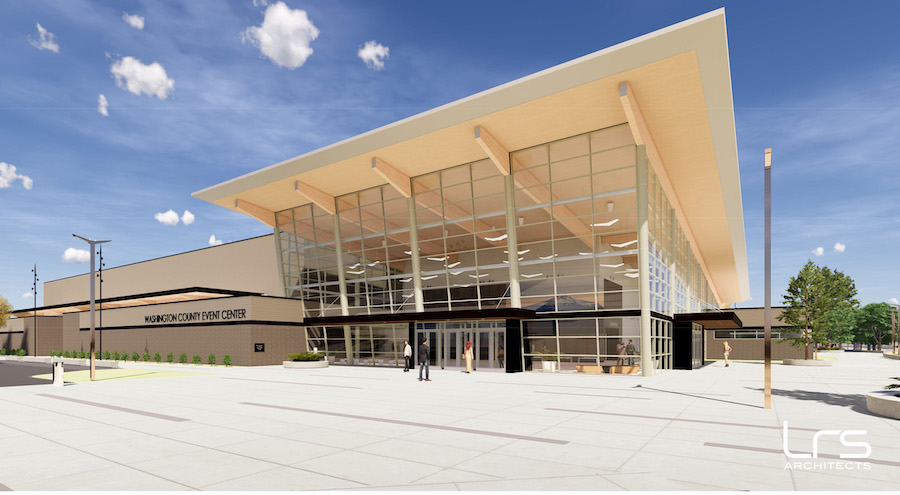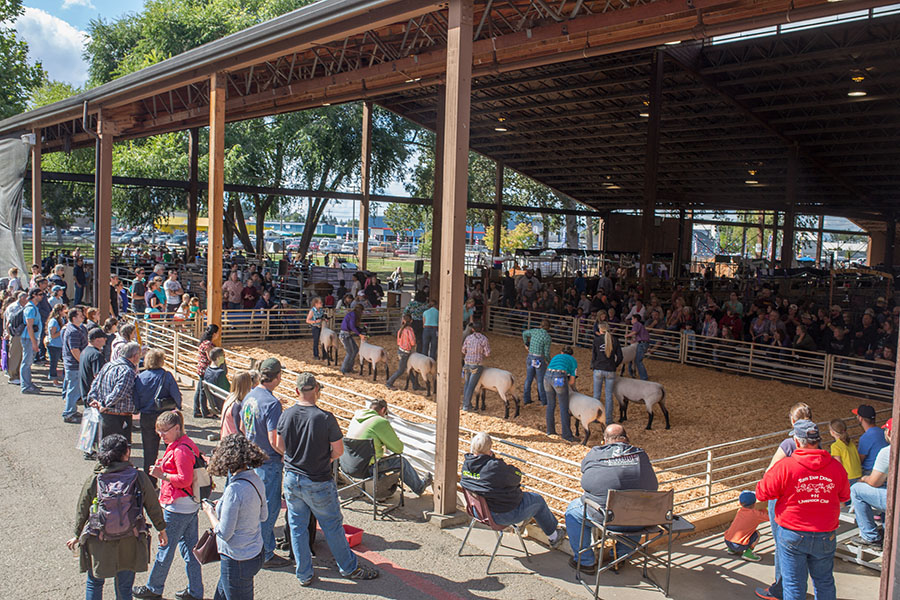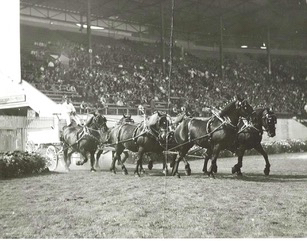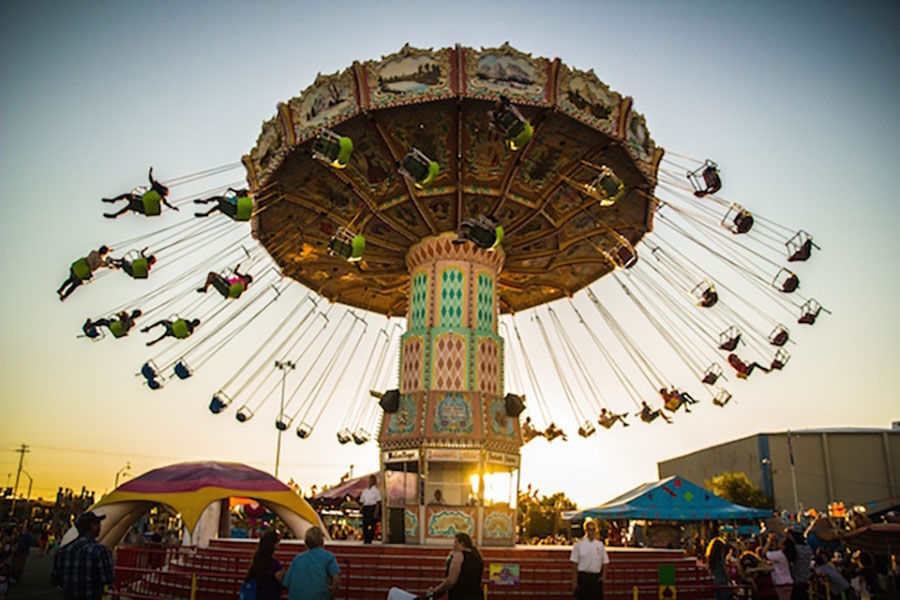State and county fairs revamp their brands to stay relevant to the region’s shifting consumer tastes.
At the Washington County Fair Complex, a stone’s throw from Hillsboro airport and Intel’s campus, construction workers in hard hats are busy readying a new 52,200-square-foot building. Scheduled to open in July this year, the state-of-the art, multiuse building will be the county’s long-awaited new meetings and events facility.
Plans to expand the Washington County Fair Complex to provide a space for year-round events have been afoot for several years.
Sitting in her office in a small prefab building behind the construction site, Lisa DuPre’, marketing and events manager for the fair for the past 22 years, still has to pinch herself that the expansion plans are becoming a reality.
“For years we have been talking about this. We finally got it done,” says DuPre’.
 Rendering of the Washington County Fair Complex’s new facility
Rendering of the Washington County Fair Complex’s new facility
The annual Washington County Fair, the first of which was held in 1854, is still going strong, averaging 100,000 visitors during the four days it is open in July. (Opening hours will be extended to 10 days this year from July 24 to August 2.)
It is a typical county fair, with rides, fried foods and craft exhibits. But to ensure the long-term stability of the event, the new building is designed to meet the broader year-round needs of the community and businesses.
“We are trying to adapt the facility to be a year-round enterprise facility,” says DuPre’.
The Washington County Fair Complex is not alone in its expansion plans. Other fairs across the state are building out their meeting spaces, adding exhibits, and hosting community and business events throughout the year to ensure their long-term survival.
Before the construction of the new facility, the Washington County Fair Complex held year-round events in an older building that dated back to the 1950s. It was less than half the size of the new facility and had no air-conditioning and no breakout rooms.
Despite these challenges, the organizers managed to hold a variety of events, including dog shows, plant sales and employee trainings.
The new $50 million venture, which was funded through Gain Share money and hotel lodging tax dollars, can hold multiple events at the same time, a feature that clients often welcome because other events sometimes complement their own. A gemstone trade show, an antiques fair, a scrapbook convention and the meeting of League of Oregon Cities are booked to take place in the new facility.
The building will also be put to use when the main event of the year — the county fair — takes place in the summer. The second phase of the redevelopment will include another multipurpose building that the fair can use for different exhibits.
It is now a trend for fairs to build event spaces that can be easily dismantled to host other events. This means that spaces can be used more frequently than for just one event.
DuPre’ says that when she started working at the fair, there was a building that solely housed pigs as part of the fair’s swine exhibit. It was eventually pulled down. Now the fair has a cement pad and a roof that allows organizers to build swine pads that can be easily assembled and dismantled.
“All fair facilities have to figure out their branding. When they remodel and go toward a multipurpose building, it has to be a flexible events space where you can still do a fair,” says DuPre’.
The annual fair is still an integral part of the complex’s yearly calendar. All age groups attend the fair, she says, including digital-obsessed millennials. Attendees are also more ethnically diverse than they used to be, she says, reflecting the county’s growing diversity.
“They may work in the digital, high-tech world. But there is still something about a fair that you want to take your kids to and eat a corn dog,” she says.
That is not to say that the fair has not evolved with the times. Organizers have adapted competitive exhibits to suit younger attendees. At one time, sewing, baked goods and canning competitions were all the rage. Now iPhone photography and watercolor and oil painting exhibits are popular.
Despite a younger, more diverse group of visitors, fried food is still the main fare. DuPre’ says organizers introduced healthy food choices, but they didn’t sell well. People still expect and want to eat corn dogs and elephant ears, says DuPre’.
“People told us, ‘I didn’t come to the fair to eat a salad.’”
The iconic Oregon State Fair, with roots that go back 154 years, has also gone through a revamp. In 2014 the state spun it off as a public corporation. It is still overseen by a governor-appointed council, but it is run more like a private business.
Kim Grewe-Powell, marketing director for the fair, says its public-corporation status means it no longer has to put out requests for proposals for all its services, such as concessionaires, making it more nimble.
“We had to go through RFPs for everything,” says Grewe-Powell. “It was very cumbersome.”
 A farm animal exhibit. Courtesy of the Oregon State Fair
A farm animal exhibit. Courtesy of the Oregon State Fair
The fair has gone through a rebranding since becoming a public corporation. Over the five years since becoming independent from the state, attendance has grown by 9% and revenue by 11%.
Grewe-Powell says the organizers changed programming after listening to feedback from the community. This was part of an effort to boost attendance, especially among young people.
“To live on in the future, we needed to attract a younger demographic,” she says.
In response to community feedback, the fair hosts created more areas for people to sit and mingle, added food carts and invited a higher level of performance acts.
The fair also added educational events in applied sciences and mathematics for younger attendees.
These so-called STEAM (Science, Technology, Engineering, Agriculture, Mathematics and Health) exhibits take place in the “creative living area” of the fair, where traditionally it exhibits homemade goods such as jams, jellies and quilts. A new STEAM event includes a stage set for robotics demonstrations, which it co-organized with the Oregon Museum of Science and Industry.
 Oregon State Fair horse team in 1940. Courtesy of the Oregon State Fair
Oregon State Fair horse team in 1940. Courtesy of the Oregon State Fair
A big change has been the fair’s focus on marketing the event through digital and social media. Last year was the first year it did Facebook Live events in which it interviewed attendees in real time and broadcast the snippets over social media.
Like the Washington County fair, the state fair has focused on boosting year-round events as an extra source of income. In the past five years, non-fair events have more than doubled. The fairgrounds are booked out every weekend for the next two years, says Grewe-Powell.
The fair organizers also brought back old-fashioned fixtures based on attendee recommendations, such as rodeo contests and motor sports, proving that the popularity of certain traditional features of a fair never grow old.
“We really increased those activities that our patrons want,” she says.
To subscribe to Oregon Business, click here.





